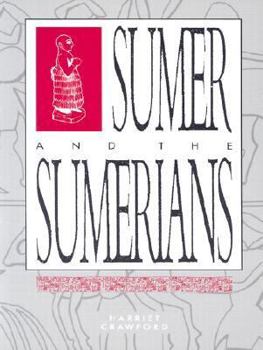Sumer and the Sumerians
Select Format
Select Condition 
Book Overview
Mesopotamia produced one of the best-known ancient civilizations, with a literate, urban culture and highly-developed political institutions. Writing primarily for a non-specialist audience but... This description may be from another edition of this product.
Format:Paperback
Language:English
ISBN:0521388503
ISBN13:9780521388504
Release Date:April 1991
Publisher:Cambridge University Press
Length:192 Pages
Weight:0.45 lbs.
Dimensions:0.3" x 7.5" x 9.7"
Customer Reviews
3 ratings
A factual description of the Sumerian civilization
Published by Thriftbooks.com User , 18 years ago
This 182 page book is one of several I have read in recent months on ancient Mesopotamia, so I was familiar with many of the topics which are included. Professor Crawford states in the preface that the book is intended for students and especially those beginning to study the archaeology and history of the Ancient Near East. She also states that the book attempts to combine a chronological account with that of a number of major themes, her emphasis being on descriptions rather than explanations. The book covers the development of the Sumerian civilization in Mesopotamia during the period c 3800BC to 2000BC, with the following themes described in separate chapters: (1) Rediscovery of the Ancient Near East: the physical environment (2) History, chronology, and social organization (3) Patterns of settlement and agriculture (4) Town planning and temple architecture (5) Public building and private housing (6) Life, death, and the meaning of the universe (7) Manufacturing industry, and trade (8) Writing and the arts (9) Conclusions - the development of Sumerian society The book includes 8 maps and 80 illustrations most of which I have seen in the other books I have read on the subject, although I do believe them to be representative of the period The reference section lists the works of some 150 authors, which includes some of the works of the early archaeologists, as well as more recent works of the 1970s and 1980s, and there is also a short index. For me the first three chapters are the most useful part of the book and provide a very good introduction to the subject. Chapter 1 is an overview of the archaeological work done to about 1990 since the 19th century rediscovery of the major sites of the Sumerian civilization, and a general description of the nature of the land, the climate and ecological zones, and the trade routes. Chapter 2 is a review of the basic periods of the development of the Sumerian civilization based on archaeological records, scientific methods of dating, and the historical record from tablets and inscriptions. Professor Crawford points out that while many of these are quite problematic and inconsistent with each other, they still provide much useful solid information Chapter 3 is a very interesting summarization of the results of a number of geographical surveys performed by Robert Adams in the 1960s, which is covered in considerably more detail in the "The Early History of the Ancient Near East" by Hans J Nissen, Chapters 4 - 8 provide detailed descriptions of the archaeological findings from the most significant Sumerian sites, with the concluding chapter discussing the outstanding characteristics which may have contributed to the development of the Sumerian civilization. I liked the fact that Professor Crawford concentrates on the facts "on the ground" and is careful to explain why some proposals put forward by earlier and eminent archaeologists are difficult to accept due to inconsistent or insuffic
Archaeology of the Sumer Delta
Published by Thriftbooks.com User , 24 years ago
This book deals with archaeological evidence of the Sumer region in a comprehensive and highly illustrated volume. Crawford's book has little to do with the historical view of Sumer like so many other books on the subject. However, she does not wonder far from most traditional views of the Sumerians and always backs those views up with a hard archaeological background. The book covers the physical environment of Sumer, social organisation, Settlement and agriculture patterns, (temple, town, housing architecture), some religious background of Sumer, Manufacturing, trade and lastly the beginnning of literature in Sumer. I suggest this book for any archaeology student interested in the use of technic in the field and evidence gathered from those technics. Crawford's book is a very educational read of the root of Mesopotamian civilsation "Sumer".
Living in Sumer
Published by Thriftbooks.com User , 24 years ago
Crawford examines Sumerian culture from an archaeological perspective. Unlike, Kramer's _The_Sumerians_ the focus is more on daily life than on mythology or historical figures. Her discussion of Sumerian religion deals more with its social aspects, how one buries the dead, how temples were laid out and the importance of the role of the priests in society, and less on the doings of the deities. Much more of the work is focused on what types of buildings the Sumerians lived in, what kinds of occupations they had, who they traded what with, and so forth. Also, throughout the work are a number of helpful maps and illustrations. The work appears to be fairly up to date and my first encounter with it was as reccommended reading for an undergraduate archaeology course.






